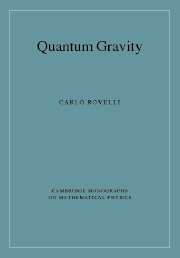8 - Applications
Published online by Cambridge University Press: 06 July 2010
Summary
In this chapter I briefly mention some of the most successful applications of LQG to concrete physical problems. I have no ambition of completeness, and I will not present any detailed derivation. For these, I refer to original papers and review articles. I only illustrate the main ideas and the main results.
The two traditional applications of quantum gravity are early cosmology and blackhole physics. In both these fields, LQG has obtained interesting results. In addition, a certain number of tentative calculations concerning other domains where Planck-scale physical effects could perhaps be observable have also been performed.
Loop quantum cosmology
A remarkable application of LQG is to early cosmology. A direct treatment of semiclassical states in Kdiff representing cosmological solutions of the Einstein equations is not yet available. However, it is possible to impose homogeneity and isotropy on the basis states and operators of the theory and, in this way, restrict the theory to a finite-dimensional system describing a quantum version of the cosmological dynamics, that can be studied in detail.
The result is different from the traditional Wheeler–DeWitt minisuperspace quantization of the dynamics of Friedmann models. The key to the difference is the fact that the system inherits certain physical aspects of the full theory. In particular, the quantization of the geometry. These have a major effect on the dynamics of the early Universe. The main results are the following.
(i) Absence of singularities. Dynamics is well defined at the Big Bang, with no singular behavior. In particular, the inverse scale factor is bounded. In this sense the Universe has a minimal size.
[…]
- Type
- Chapter
- Information
- Quantum Gravity , pp. 296 - 319Publisher: Cambridge University PressPrint publication year: 2004

